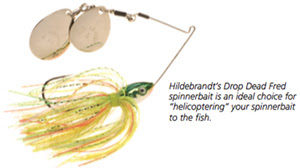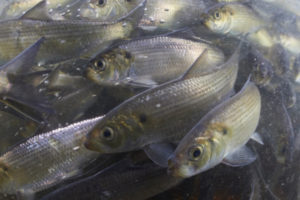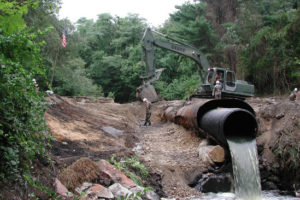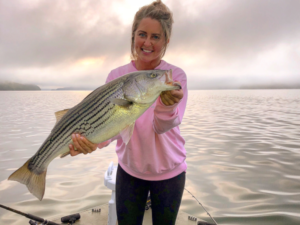Tips for Bassing with Spinnerbaits
by Marc Marcantoni, Yakima Baits Pro Staff
from The Fishing Wire

Spinnerbait
A spinnerbait is one of the most reliable lures for catching bass anywhere they are found. New materials like tin bodies, high-tech UV finishes, and better manufacturing processes make spinnerbaits deadlier than ever. Anyone can catch fish on a spinnerbait, once you learn some basic principles.
You may wonder what in nature could possibly resemble this awkward looking contraption, and why would fish eat them? Look at a spinnerbait from a fish-eye perspective, below the surface, rather than from your perspective when holding one in your hand.
Bass eat bait fish, which a spinnerbait mimics so well with its vibration and flash. These features attract fish from a long distance. The flash of the spinning blades is visible from a distance and mimics the flash of a school of bait fish. In stained water flash is less visible, but the vibration produced by the blades is felt by the sensitive nerve endings in the bass’ lateral line. Fish hunt their food by sight, hearing and feel. When they home-in on the flash and vibration, the bait fish appearance of the spinnerbait body seals the deal, resulting in vicious strikes that do not require a sensitive rod to detect.
What makes a spinnerbait unique and particularly effective is how it can be fished in heavy cover without snagging. Spinnerbaits were designed with this objective and are virtually snagfree thanks to the upturned single hook that’s directly in line with the wire arms. This allows a spinnerbait to be pulled over the top of fallen tree branches and through submerged vegetation, where bass like to hunt for bait fish. Astute anglers cast spinnerbaits beyond every type of heavy cover, and swim the lure so it comes in contact with cover and structure.
Spinnerbaits are Fish Finders
Whether fishing unfamiliar waters or your local lake, spinnerbaits are ideal for hunting your quarry. They allow you to quickly learn where fish are located. Unlike fishing soft plastics, spinnerbaits are retrieved more quickly, allowing the searching angler to cover a lot of water efficiently. Probing both shallow and deep water can be accomplished with these unique safety-pin inspired lures, and in minimal time. There is no better lure made for quickly determining where bass are located. How they attack your spinnerbait will also expose their temperament.
When bass are aggressive and jumping on your spinnerbait, stick with it. If they follow but don’t strike, consider making a change in color, size, or style of blades. If the spinnerbait is ignored, you can bet the fish are telling you to slow down and try different lures and methods better suited for inactive fish.
Where and How to Use Them
The most successful retrieve in shallow water allows the spinning blades to bulge the surface, without causing them to break through the water. A fleeing bait fish provides the same disturbance to the calm surface water of a lake, river, or pond. Predatory fish use the surface of the water as a barrier, making it easier to capture their prey by preventing escape by swimming up higher.
Added attraction can be created by momentarily stopping the retrieve just long enough to cause the spinnerbait to stutter. The momentary change of blade speed, coupled with a drop of the lure during the brief pause, will often trigger a strike from a following fish. Pausing a spinnerbait next to cover can inspire a reaction strike from inactive fish. Even better, whenever possible swim your spinnerbait so that it crashes into stumps, dock pilings, branches, or any other cover. The sudden change of direction created by the contact with the cover triggers arm-jarring strikes.
A spinnerbait is also deadly in deep water. Bait fish follow their food, not only in shallow water but in deep water too. When schools of bait fish go deep, largemouth, smallmouth and spotted bass follow. This often happens where the water is calm and clear. In deep water, the key to success with a spinnerbait is to place your lure at the same depth used by the bait fish.
When the proper depth intersects with a piece of cover like a bridge piling, boulder, or deep weed edge, you want to place your spinnerbait in the same spot. Again, bump your spinnerbait into the cover, or otherwise twitch or pause the lure next to the deep cover. The change of direction is what triggers the strike.
Getting your spinnerbait to work in deep water requires understanding how to select the proper model, especially its weight, blade size and blade shape.
At times the most effective method of fishing a spinnerbait doesn’t rely on a retrieve. “Helicoptering” spinnerbaits involves pitching (a form of lobbing the spinnerbait) or casting to a target and allowing the spinnerbait to fall vertically along that target. Bass, as ambush predators, will charge out and grab it on the fall. You’ll likely see the bite before you feel it. Your line will jump or trail off one way or the other, when that happens…set the hook! The Drop Dead FredTM made by Hildebrandt® was expressly designed for this highly effective application. The design of this spinnerbait allows for a slow fall which keeps the bait working longer through the water column.
Wind is Your Friend
Many anglers find fishing in the wind to be uncomfortable, and because of that avoid it whenever possible. Wind and spinnerbaits go together better than peanut butter and jelly. Bass utilize wind to hunt more easily for bait fish that struggle in the waves. Because waves break up the light penetration, bait fish tend to locate near the surface. A quickly moving spinnerbait is the best tool to exploit wind conditions, and it is common to load the boat by fishing spinnerbaits in the wind and waves.
Current Can Also Help
Like wind, current collects bait fish and predatory fish, making current seams prime locations to fish a spinnerbait. Current seams create an edge, or barrier (like the surface or the bottom) that fish utilize to trap their prey. Study any river, tidal flat, or lake to locate current seams, and cast your spinnerbait so it runs where the moving water and calm water meet. Position yourself so that you cast up-current, and retrieve your spinnerbait in the same direction as the water flow. Predators expect bait fish to move with the current, and you will catch more bass by paying attention to this.
Selecting the Right Spinnerbait
The best spinnerbait is one that matches the conditions, and best imitates bait fish. Each component must be considered to match the water color and clarity, depth, type of cover, and activity level of your quarry. Spinnerbait models vary by the quality and thickness of the wire, the color, shape, and size of the blades, the body size and material used for the body (including the skirt), the length and size of the hook, and the quality of the swivel used. The number of possible combinations of components is endless, and no tackle box or budget can cover all the bases. The wise angler buys an assortment of models with changeable components, and then adjusts each spinnerbait to produce the flash, vibration, size and color that produces the best combination for the fishing conditions.
The most important component of a spinnerbait to consider is the blades. When selecting the proper blade, always start with a good quality blade that spins at a variety of speeds. Hildebrandt® is the industry leader in manufacturing top- quality blades. They are balanced and shaped perfectly, with precision thickness and taper. Hildebrandt® blades are matched with a genuine Sampo® ball-bearing swivel, to ensure the blades are free-spinning. The thick plate finish is polished.
To reflect maximum light, and the copper blades are lacquer coated to prevent tarnishing. The bottom line is when you purchase a Hildebrandt spinnerbait, or packages of Hildebrandt blades, you catch more fish!
Colorado blades are rounded, and produce the most vibration and lift. Because of these characteristics, they allow you to fish a spinnerbait more slowly than other blade shapes. They are the best choice for fishing in shallow, cold water, or when- ever bass are less aggressive and responding to slower presentations. The additional vibration is important when fishing stained water or low-light conditions where bass use their sense of feel to locate prey, more than their sense of sight.
Willow-leaf blades are shaped like their namesake, and produce more flash and less vibration. A spinnerbait with willow-leaf blades can be retrieved much faster, and much deeper. They are the blade of choice when fish are deep, since they do not cause your spinnerbait to lift when retrieved. They allow you to fish a spinnerbait at maximum speed, making them a great choice when water temperatures exceed 70 degrees and bass are aggressive. In clear water, a fast retrieve can trigger a bass to strike before it gets a good look at the lure. Willow-leaf blades produce the most flash, and when fished at high speeds they will produce great results in clear water.
Blade color can be silver, copper, gold, or painted. Silver is typically a good choice for clear water, and in bright, sunny conditions. Copper blades are best when fishing water that is generally clear, but with a tannic or dark stain. Gold or brass is preferable when the bait fish have yellow highlights, like golden shiners. Painted blades cover a variety of conditions. Chartreuse is used in muddy water, white in low light conditions with clear water, and combinations of both cover a variety of situations. Hildebrandt offers their Elite Pro SeriesTM spinnerbait in True LifeTM painted blades that add a striking bait fish appeal with UV finishes for maximum visibility under all light and water color conditions.
Experiment with blade color to find the color(s) that are most effective in the water you’re fishing.
Hildebrandt spinnerbaits have been purposely designed with this concept in mind. They feature an innovative, quick-change clevis so you can change your blade in seconds as you look for the most effective blade and color combination. Rather than purchasing and carrying dozens of spinnerbaits with different blades, Hildebrandt spinnerbaits allow you to carry several different weight or style spinnerbaits, all with the ability to add the desired blade shape or finish of your choice. Spare Hildebrandt blades in all sizes, shapes and finishes are available from full service tackle dealers around the country.
Skirts and trailers can also be changed, and are also readily available from your dealer.
The spinnerbait body serves several important functions. It assures your spinnerbait runs straight with the hook in the up position; it provides a life-like minnow profile to target; and also serves to hold skirts or soft plastic trailers for added enticement.
Spinnerbaits designed for largemouth bass generally have larger frames, heavier gauge wire, and larger blades. Hildebrandt spinnerbaits like the Tin RollerTM, the Okeechobee SpecialTM, and the new Drum RollerTM are popular choices and sport the quick-change blade feature. Largemouth bass spend much of their time in shallow water, especially around heavy cover so the beefier construction is critical.
When selecting the most appropriate spinnerbait, choose one that allows you to match the bait fish largemouth bass are eating. Identifying the best retrieve speed, amount of flash, and the amount of vibration necessary in triggering strikes will determine the amount of success you have. Speed and vibration are controlled by both the reel retrieve speed and by the style of blades on the spinnerbait. By changing the sizes and style (Willow-leaf or Colorado) of the blades, you can adjust the degree of flash and vibration to fine tune your presentation.
Smallmouth bass and spotted bass are frequently found in open water, and they forage on smaller bait fish, so a more compact design works better. The new Hildebrandt Double DeepTM is deadly for both species. Weighing in at one-ounce, and paired with Willow-leaf blades, allows you to achieve maximum depth and speed that isn’t possible with other designs. The overall size is more compact, and the smaller gauge stainless steel wire provides the perfect vibration, without sacrificing strength. Use a #3.5 blade when you need maximum speed and less ash. A #4.0 blade is the most commonly used size for most conditions, and a larger #4.5 blade can be used for slower speeds, more flash, and stronger vibration. Each blade size has a time and place, so carry all sizes and experiment until you dial-in the best for the day.
Give Them What They Want
When bass are aggressive and attack your spinnerbait, you’ve found the ideal combination of speed, size, and color. If they follow and turn-away instead of striking, they are telling you they are interested, but the color or size is wrong. In most cases a simple color change fixes the problem, and changing the rear blade will likely make the difference. A skirt change would be the next best choice, and finally a change in weight and retrieve speed should be considered.
Just under the surface, in and around structure, in deep water and all points in-between, spinnerbaits have earned their place as a primary bait in catching all species of bass. Apply this know-how of size, color, speed and depth, being mindful of how you approach your targets and fishing bass-holding water and you’ll find spinnerbaits will occupy a place of prominence in your fishing strategy too.
Marc Marcantonio is an accomplished tournament bass fishing professional with three IGFA world records to his name along with a long list of impressive tournament wins and credentials. Marc is also a member of the Yakima Bait pro-staff. Beyond Marc’s tournament activities he’s a frequent seminar speaker and writer.





